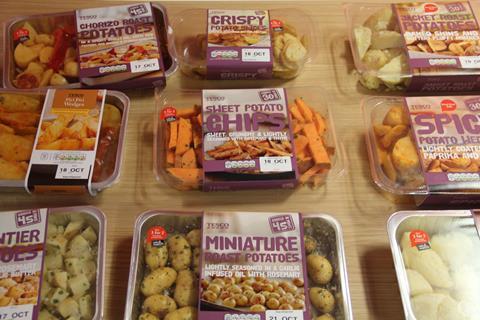
Wet weather and high temperatures made it a tough season for potato growers. Adverse conditions have brought reduced quality, high levels of outgrade and, in all likelihood, reduced yields for many. Blight, growth cracks and greens and bruising have all caused producers headaches this year.
“The weather pattern across western Europe in 2016 has been far from ideal for potato production,” says Albert Bartlett’s technical and procurement director Paddy Graham-Jones. Wet weather in the spring delayed planting, and an unusually wet June led to flooding, the extension of fungicide spray intervals and, ultimately, blight.
The rain then eased off in July, but high temperatures in August and September dried out soils – and this has boosted levels of tuber dry matter, according to Graham-Jones, who complains of high levels of bruising in his crop.
Of even greater concern to growers has been the abundance of growth cracks and greens in this year’s crop, provoked by variable soil moisture. “I get the feeling that yields are going to be down this year,” says Norfolk grower Tim Papworth of LF Papworth. “Overall about 10 per cent of the crop is waste because of the growth cracks and greens. You wouldn’t get this much waste in a normal year.”
The UK has not been the only country affected. The late spring and wet June “have had a big effect on both cropoutput andquality for the top five potato-producingcountries in northern Europe,” according to Richard Arundel of Arundel Kerr Produce (AKP).
But in the UK, producers’ concerns have been compounded by a steady decline in consumption. A two per cent year-on-year drop in retail value sales [KWP 52 w/e 11 September 2016] has been driven by a combination of price deflation and shoppers buying less per trip.
“Modern lifestyles have led to more time pressures on consumers to prepare quicker and more convenient meal options,” explains Stu Baker, consumer marcomms manager at AHDB Potatoes. In 1980, the average time to prepare and cook an evening meal was 60 minutes, but this has now fallen to half an hour. In line with this trend, many consumers are viewing potatoes as a less convenient option than carbohydrate rivals rice and pasta, which can be microwaved in minutes.
When British consumers do choose potatoes, the trend is towards small pack purchases, “so that the whole pack can be consumed within one or two sittings with minimal waste”, Arundel says. This has made salad and baking potatoes increasingly popular, but sales of old potatoes have suffered. “Unfortunately, gone are the days whenhouseholds purchased a large pack of potatoes and consumed them over thecourse of a week,” he says.
Part of the problem, according to Papworth, is a lack of consumer understanding about how to store potatoes and the point at which they are no longer safe to eat. “When they start to grow and shoot, consumers might think they have gone off,” he says. “But they are good to eat until they start to rot.”
It’s not all doom and gloom, however. The thirst for convenience has created growing opportunities in the prepared sector, with products like pre-cooked mash and frozen jackets selling well. “There are exciting times ahead for prepared potatoes with strong growth in this area,” says Greenvale commercial director Andy Clarkson, who also points to growing demand in foodservice as restaurants and pub chains try to reduce labour costs by switching to prepared products.
One of the processing companies looking to capitalise on this trend is Greenvale’s sister firm Swancote Foods. It supplies fresh and pasteurised cooked or part-cooked potatoes to manufacturing companies, who then process them further before turning them into potato-based products. In a bid to satisfy growing demand for prepared potato products, the business has invested over £2 million in updated equipment over the past three years. Similarly, Branston is now collaborating with convenience food producer Samworth Brothers (see p20) to get the most out of its surplus produce. Demand is also growing for premium potatoes, according to Greenvale, with Sainsbury’s Taste the Difference British Gems enjoying strong sales this year, and its on-shelf presence extended by four weeks.
In terms of varietal innovation, Red Fantasy – also grown by Greenvale – is one to watch out for. The premium variety, which has red skin and golden flesh, will be launched exclusively in Tesco in October. Building on the success of its Mayan Gold roasting potato, the producer will also add Mayan Rose to its range. Like Mayan Gold, it is an ancient Peruvian variety that is reputed to date back over 7,000 years.
The potato industry will be hoping that new formats as well as these ancient varieties can help boost sales – whatever the weather.



